

#CHAPTER 12 MONOPOLY ECONOMICS QUIZLET WINDOWS#
In 2013, the Windows system ran on more than 90% of the most commonly sold personal computers. Since nearly everyone was using Windows, including Internet Explorer eliminated the incentive for consumers to explore other browsers and made it impossible for competitors to gain a foothold in the market.
#CHAPTER 12 MONOPOLY ECONOMICS QUIZLET FREE#
The Justice Department’s argument was that, since Microsoft possessed an extremely high market share in the industry for operating systems, the inclusion of a free web browser constituted unfair competition to other browsers, such as Netscape Navigator. Department of Justice prosecuted the Microsoft Corporation for including Internet Explorer as the default web browser with its operating system. Some new drugs are produced by only one pharmaceutical firm-and no close substitutes for that drug may exist.įrom the mid-1990s until 2004, the U.S. Postal Service, your electric, and garbage collection companies are a few examples. Department of Justice uses.Įven though there are very few true monopolies in existence, we do deal with some of those few every day, often without realizing it: The U.S. This tends to be the definition that the U.S. While a monopoly, by definition, refers to a single firm, in practice people often use the term to describe a market in which one firm merely has a very high market share.

Since a monopoly faces no significant competition, it can charge any price it wishes, subject to the demand curve. In the case of monopoly, one firm produces all of the output in a market. If perfect competition is a market where firms have no market power and they simply respond to the market price, monopoly is a market with no competition at all, and firms have a great deal of market power. In this chapter, we explore the opposite extreme: monopoly. Think about it this way: If you very much wanted to win an Olympic gold medal, would you rather be far better than everyone else, or locked in competition with many athletes just as good as you? Similarly, if you would like to attain a very high level of profits, would you rather manage a business with little or no competition, or struggle against many tough competitors who are trying to sell to your customers? By now, you might have read the chapter on Perfect Competition. Many believe that top executives at firms are the strongest supporters of market competition, but this belief is far from the truth. How do monopoly firms behave in the marketplace? Do they have “power?” Does this power potentially have unintended consequences? We’ll return to this case at the end of the chapter to see how the tea and cotton monopolies influenced U.S. This leads us to this chapter's topic: a firm that controls all (or nearly all) of the supply of a good or service-a monopoly. The South, wanting to secede from the Union, hoped to leverage Britain’s high dependency on its cotton into formal diplomatic recognition of the Confederate States of America.

At that time, the Southern states provided the majority of the cotton Britain imported. Step forward in time to 1860-the eve of the American Civil War-to another near monopoly supplier of historical significance: the U.S. They refused to permit the unloading of tea, citing their main complaint: “No taxation without representation.” Several newspapers, including The Massachusetts Gazette, warned arriving tea-bearing ships, “We are prepared, and shall not fail to pay them an unwelcome visit by The Mohawks.” By November, the citizens of Boston had had enough. The act continued the tax on teas and made the East India Company the sole legal supplier of tea to the American colonies. To help shore up the failing firm, the British Parliament authorized the Tea Act. In spring 1773, the East India Company, a firm that, in its time, was designated “too big to fail,” was experiencing financial difficulties. This one steps into the past to observe how monopoly, or near monopolies, have helped shape history. Columns 1 and 2 of the table set out the market demand schedule for Minnie's water and columns 2 and 3 set out Minnie's total cost schedule.Many of the opening case studies have focused on current events. Use the following table to work Problems 2 to 4 Minnie's Mineral Springs is a single-price monopoly. Are any these firms protected by a barrier to entry? Do any of these firms produce a good or service that has a substitute? Might any of them be able to profit from price discrimination? Explain your answers. Cox Communications is the sole provider of $\mathrm-$ ble television service in some parts of San Diego. makes LIPITOR, a prescription drug that lowers cholesterol. Postal Service has a monopoly on nonurgent First Class Mail.


 0 kommentar(er)
0 kommentar(er)
